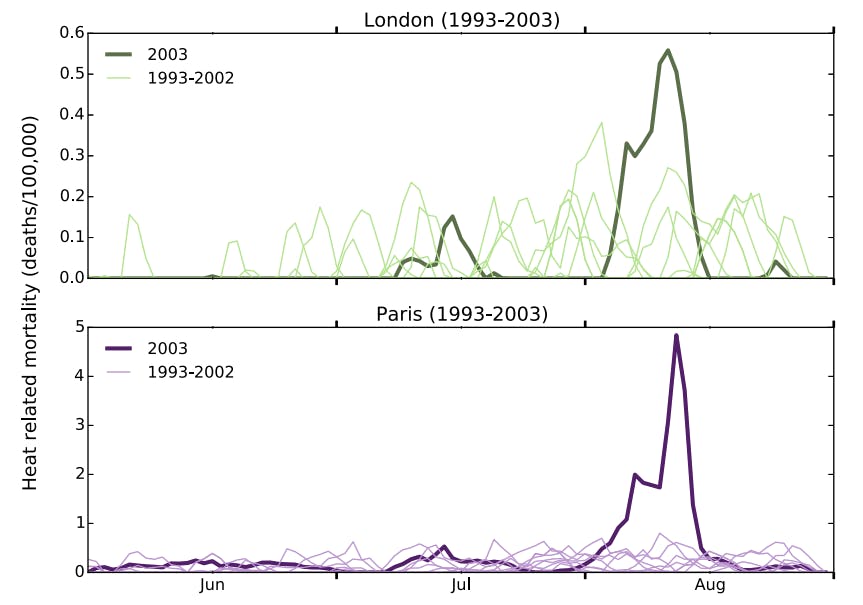France was among the worst-affected countries, with 15,000 deaths in August alone. In the UK, the summer saw more than 2,000 heat-related fatalities.
A new first-of-a-kind study works out how many of the deaths in Paris and London are down to the heatwave being intensified by human-caused climate change.
The findings suggest that 506 of the 735 summer fatalities in Paris in 2003, and 64 of the 315 in London, were a result of human influence on the climate.
“
We have a statistical relationship between the number of additional deaths per degree of warming.
Dr Daniel Mitchell, lead author and researcher, Department of Physics, University of Oxford
Human influence
The European summer heatwave of 2003 has been something of a focal point for scientists looking at if and how human-caused climate change influences extreme weather events.
In 2004, the heatwave was the subject of the first ever attribution study, which found that climate warming from human activity had at least doubled the likelihood of such an event. In 2014, another study found that a similar “extremely hot” summer in Europe has become 10 times more likely over the last 10-15 years because of climate change.
Taking this a step further, the new study, published in Environmental Research Letters, attributes the number of deaths during the 2003 heatwave to our warming climate.
The study makes use of the weather@home project, where members of the public offer spare capacity on their home computers for scientists to run model simulations.
The researchers ran thousands of simulations of European weather in 2003. One set of model runs simulated the weather according to the climate as it was – i.e. in a world warmed by past greenhouse gas emissions. The second set simulated the weather in a hypothetical world with no human influences on climate.
The researchers then compared the heat and humidity between the hypothetical world and the one better matched to reality to see how they affect the number of premature deaths in the summer of the same year.
Lead author Dr Daniel Mitchell, a researcher in the Department of Physics at the University of Oxford, explains to Carbon Brief: “We have a statistical relationship between the number of additional deaths per degree of warming. This is specific to a certain city, and changes a lot between cities. We use climate simulations to calculate the heat in 2003, and in 2003 without human influences. Then we compare the simulations, along with the observations.”
The authors’ comparison shows that human-induced climate change was responsible for 70 per cent of heat-related deaths in central Paris, and 20 per cent in Greater London.
This means, of the 735 heat-related deaths in Paris during the summer of 2003, 506 were due to human-caused climate change. For London, it was 64 out of 315.
Heat-related deaths
The charts below highlight the impact of the 2003 heatwave on London (upper chart) and Paris (lower chart). They show the estimated heat-related deaths per day during the summer for 2003 (thick line) and the 10 preceding years, which didn’t have major heatwave events (thin lines). You can see the peaks in heat-deaths in mid-July and mid-August.
Between June and August 2003, the total rate of heat-related deaths was 4.5 per 100,000 people for London and 34 per 100,000 for Paris, the paper says. Note, these figures differ from those in the charts below because they’re totals for the whole summer, rather than the heat-deaths per day, which the charts show.

Daily time series of estimated heat-related deaths (per 100,000 of population) during the summer for London (upper chart) and Paris (lower chart). The charts show number of deaths in 2003 (thick lines) and for each year of 1993-2002 (thin lines). Source: Mitchell et al. (2016).
As the study looked at just two affected cities, the total number of deaths due to the influence of climate change on the heatwave will be much higher, the paper notes: “London and Paris are just two of a large number of cities that were impacted by the 2003 heatwave, therefore the total European-wide mortality count attributable to anthropogenic climate change is likely to be orders of magnitude larger than this.”
Future heatwaves
The study is the first to apply a standard attribution methodology to look at mortality during a specific extreme weather event, says Dr Nikos Christidis from the Met Office, who wasn’t involved in this study, but authored another about European heatwaves. He tells Carbon Brief about the benefits of using this approach:
“An obvious one is that the study analyses mortality – i.e. a direct impact measure – rather than temperature – an indirect impact measure, which might be more useful to some decision makers.”
On the other hand, a drawback is that linking mortalities into climate means adding another level of uncertainty into the analysis, Christidis says. This can be an issue if scientists don’t have long and reliable health datasets to use in their analysis.
Looking ahead, the paper notes that the next task is to assess the potential risks of future heatwaves as the climate warms further. But this is tricky, notes Mitchell, as there are social factors involved, such as population growth: “We suggest that mortality rates will, in general, rise in future heatwaves as they become larger in magnitude.”
This story is published with permission from Carbon Brief under a Creative Common license.










